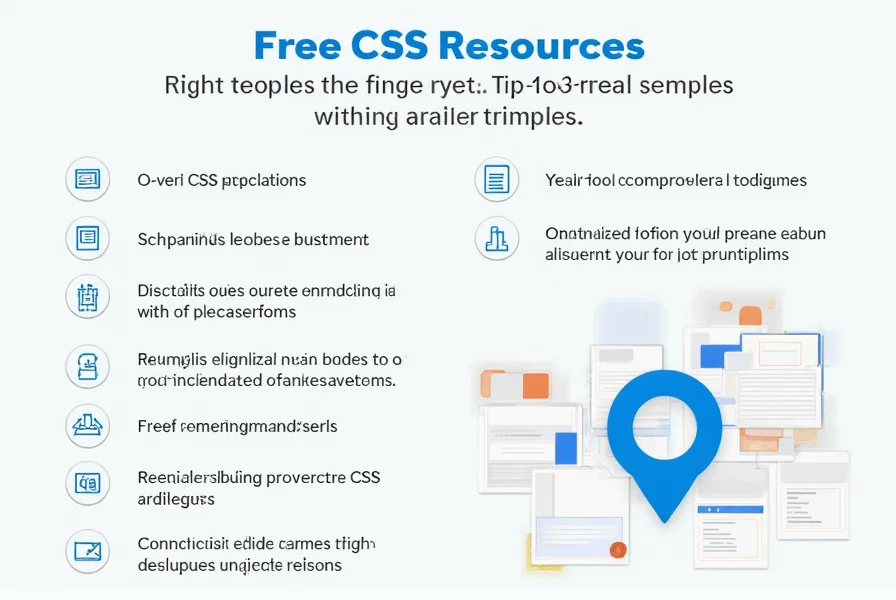Free CSS resources have become essential tools for web developers seeking efficient, responsive design solutions. Whether you're building a simple personal website or a complex web application, leveraging free CSS frameworks and templates can significantly accelerate your development process while maintaining professional quality standards.
Understanding Free CSS Frameworks
CSS frameworks provide pre-written CSS code that establishes consistent styling patterns across websites. The most popular free CSS frameworks offer responsive grid systems, typography defaults, form controls, and UI components that work across different browsers and devices. Unlike premium options, these free resources typically operate under open-source licenses that permit both personal and commercial usage with proper attribution.
Top Free CSS Frameworks Comparison
| Framework | License Type | File Size (Minified) | Key Features | Best For |
|---|---|---|---|---|
| Bootstrap 5 | MIT | 22KB | 12-column grid, utility classes, components library | Enterprise applications, admin dashboards |
| Foundation 6 | MIT | 20KB | Mobile-first approach, accessibility features | Marketing sites, responsive email templates |
| Bulma | MIT | 18KB | Flexbox-based, no JavaScript dependency | Modern single-page applications |
| Tailwind CSS | MIT | 15KB | Utility-first, highly customizable | Custom design systems, rapid prototyping |
Where to Find Quality Free CSS Templates
Several reputable platforms host high-quality free CSS templates that you can implement immediately. GitHub remains the largest repository of open-source CSS projects, with thousands of template options searchable by license type and framework. Template-specific sites like HTML5 UP offer responsive templates under the Creative Commons Attribution 3.0 license, requiring only proper credit to the original creator.
When evaluating free CSS template sources, consider these factors:
- License clarity and commercial usage permissions
- Browser compatibility testing results
- Last update date (within past 12 months preferred)
- Community support and documentation quality
- Mobile responsiveness verification
Implementing Free CSS Resources Effectively
Simply adding a free CSS framework to your project won't guarantee optimal results. Strategic implementation requires understanding how to customize without breaking responsiveness. Most frameworks allow customization through Sass variables or build tools that let you include only the components you need, reducing final file size.
For production environments, always:
- Minify CSS files before deployment
- Remove unused components through tree-shaking
- Test across multiple device sizes
- Verify accessibility compliance (WCAG 2.1)
- Check for potential security vulnerabilities in dependencies
Legal Considerations for Free CSS Usage
Understanding licensing requirements prevents future legal complications. The MIT license, common among free CSS frameworks, requires only that you include the original copyright notice and license text in your distribution. More restrictive licenses like GPL may require your entire project to adopt the same license terms.
When using free CSS resources, maintain a license inventory that documents:
- Resource name and version
- Original source URL
- License type
- Required attribution format
- Any modifications made to the original
Emerging Trends in Free CSS Development
The free CSS ecosystem continues evolving with new approaches to styling. Container queries, now supported in modern browsers, enable more context-aware component styling without JavaScript. CSS subgrid implementation has improved layout flexibility while reducing unnecessary DOM elements. The growing adoption of CSS variables (custom properties) allows for more dynamic theme switching within free frameworks.
Developers should monitor these emerging patterns when selecting free CSS resources:
- Adoption of CSS nesting for cleaner code organization
- Integration with design token systems
- Support for prefers-color-scheme media queries
- Performance optimization through layering
- Accessibility-first component design patterns
FAQ
Can I use free CSS frameworks for commercial projects?
Yes, most popular free CSS frameworks like Bootstrap, Foundation, and Bulma use the MIT license which explicitly permits commercial use. Always verify the specific license terms of each resource, as some may require attribution or have additional conditions.
What's the difference between free CSS frameworks and premium options?
Free CSS frameworks typically offer core functionality with community support, while premium options often include advanced components, dedicated support, and specialized templates. The primary difference lies in extended features and professional services rather than fundamental capabilities, as many free frameworks power enterprise-level applications.
How do I properly attribute free CSS resources in my project?
For MIT-licensed resources, include the original copyright notice and license text in your project's documentation or a dedicated license file. Many developers place attribution in the website footer or within a "credits" section of documentation. Always follow the specific attribution requirements outlined in each resource's license file.
Are free CSS frameworks secure to use in production environments?
Reputable free CSS frameworks maintained by active communities are generally secure for production use. However, you should always check for known vulnerabilities, keep frameworks updated, and remove unused components. Major frameworks like Bootstrap undergo regular security audits by their development teams and community contributors.











 浙公网安备
33010002000092号
浙公网安备
33010002000092号 浙B2-20120091-4
浙B2-20120091-4